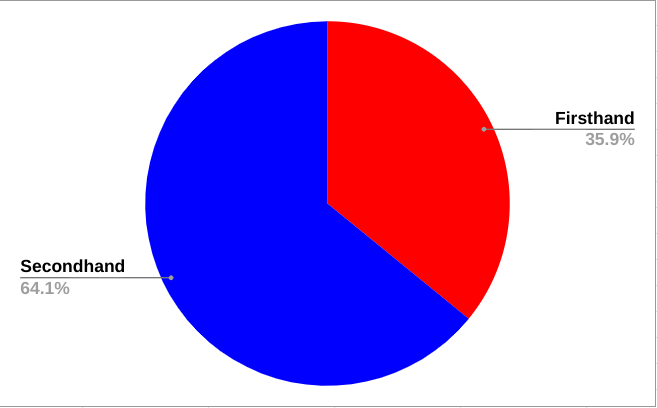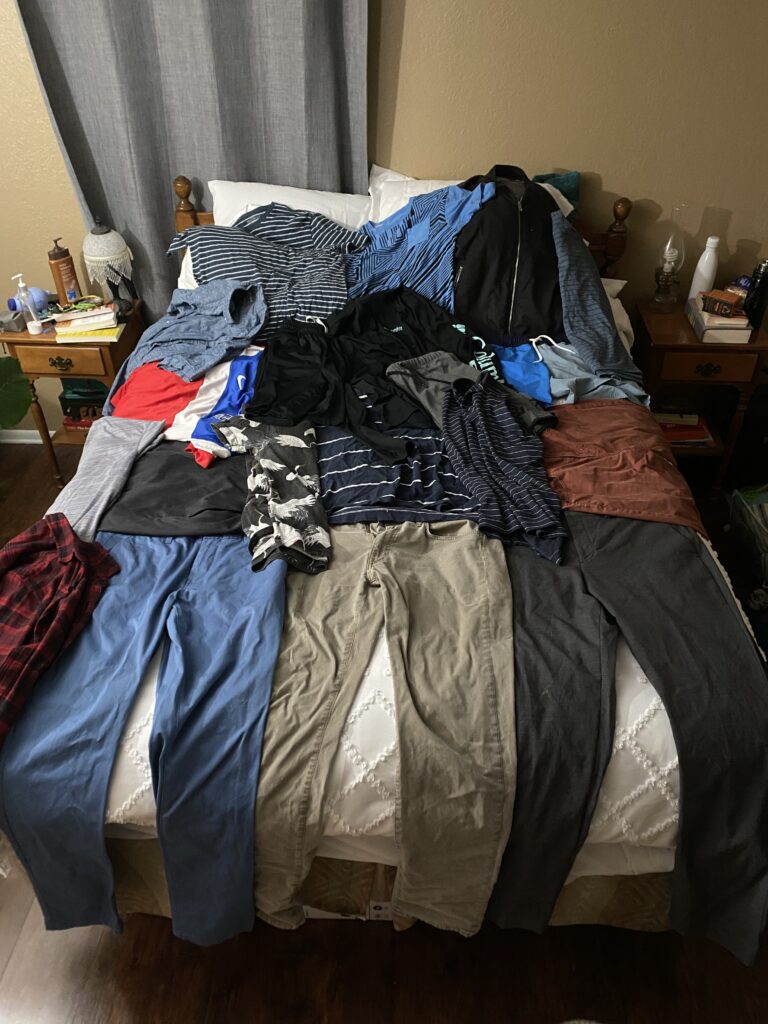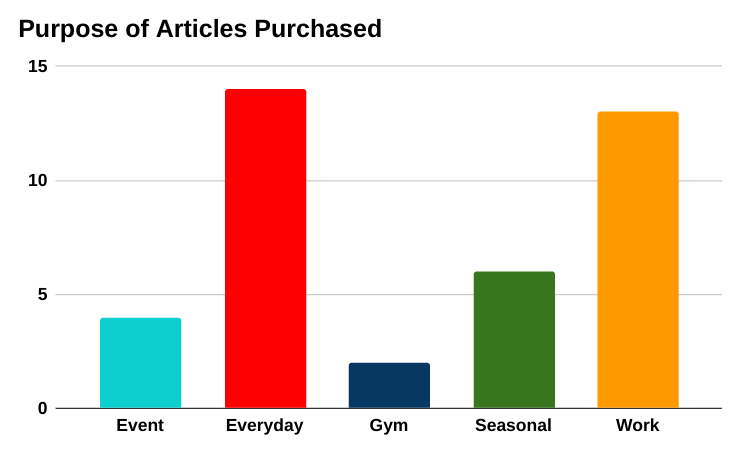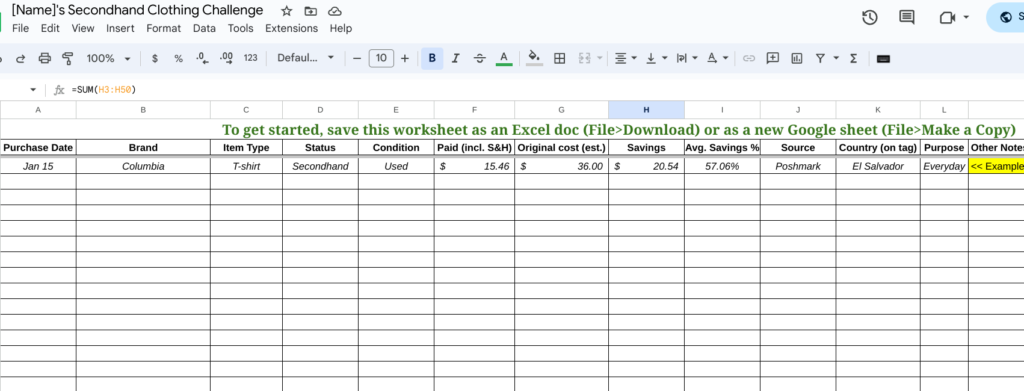
My personal challenge for 2022 was to buy 75% of my clothing purchases from secondhand sources.
Quick jumps
- Intro (just scroll down like one inch)
- Results and Charts
- Takeaways
- Try it Yourself
Crippling inflation and the million-and-one sustainability reasons to buy secondhand aside, this year turned out to be the perfect time for such an experiment and a major wardrobe renovation:
- From M to L: I gained 10-15 pounds from September through the New Year, finally making me look like a real man according to my mother-in-law. Accustomed to wearing things on the smaller side (thanks 2000s adolescence), this saw me needing to replace quite a few everyday items in my wardrobe.
- Return to Office, Collars: Working in an office regularly for the first time in seven years made me realize how much I lacked in professional attire…and that’s in an office where hoodies and jeans aren’t uncommon.
- New Climate, New Me: Even though I’ve been in Florida for several years, my wardrobe has been slow to adjust to the uncomfortably hot springsummerfalls and near year-round shorts and short-sleeves weather.
Although my focus was on buying pre-loved clothes, I counted new-with-tag items as secondhand if they were purchased from a “secondary” source like Poshmark or eBay.
I also tried hard not to deliberately balance out any firsthand-new purchase with a secondhand one just to skew back my purchase percentage. While it wouldn’t be propagating the same produce→sell→produce cycle, it’s still consumption without direct need that lands me with an item that someday I (or my heirs) will be tasked with disposing of.
The Result: I Failed, But It's Cool
The past calendar year, I made 39 clothing purchases, 25 of which came from secondhand sources (64%).
As mentioned, firsthand simply means the item was purchased from a retail store or directly from the brand itself; secondhand means from basically any other source. Thus, I counted a secondhand item as new if it was unworn and still had its original tags.

Although I failed to meet my goal, overall I’m more than satisfied with this ratio—I feel that I bought secondhand as much as I could. And if you discard the categories I find nearly impossible to buy secondhand—shoes and socks—this percentage rises to 72%.
While the only real goal was to hit that 75/25 balance, out of curiously I tracked a few other metrics:
Cost Paid and Savings %
For those 39 purchases, I paid $1,135 for items that originally cost $2,110 total for a 48% savings rate ($975). My three most expensive purchases ($111, $84, $78) accounted for over 1/4 of what I spent for the entire year.

For any secondhand purchase, I tried to find the original retailer’s MSRP to figure out how much I had saved. If not, I made my best estimate based on similar items produced by that company, but did not include any hypothetical shipping costs. However, for secondhand online purchases I did add the S&H into the total cost.
Overall, saving nearly $1,000 mostly by browsing Poshmark from my couch and toilet felt pretty damn cool. This savings doesn’t even factor in the money I would have spent on gas or food that add up when shopping the traditional retail way, let alone the incalculable time savings and opportunity costs.
I’ve done the track-everything-you-spend experiment for periods of time before, but I was still taken aback with how much I had spent throughout the year—if I had to guess (and didn’t know the running total) I probably would have been off by $400 or $500. One thought is that knowing I was mostly buying discounted clothing gave me a false sense of security and mental permission to loosen my wallet strings more than I would have normally.
Country of Origin
I also tracked the alleged country of production listed on each item’s tag.

I say ‘alleged’ because, much like cars, it’s often an oversimplification to say an article of clothing was made in just one place due to the complex supply chain and production webs that make up modern manufacturing. While a fast fashion company like Zara could contract an outside company to create a pair of jeans, that second company could then outsource to yet more companies to do the stitching, buttons, or washing of the article.
This makes a piece of clothing’s true origin extremely enigmatic and probably impossible for someone not-in-the-industry to determine, but I was curious to see if there was ANYTHING I purchased that claimed to be made here in the United States. In the end, only two items were, both of which were purchased off of Etsy for a Halloween costume.
Purpose of Purchase
I also recorded the reason I bought each item.
At first, I tried to label things as being purchased for “Fun” or “Wardrobe replacement”, but that ended up being messy with many overlapping categories. In the end, I rejiggered everything to fit into five groups that aligned more with the original reasons for my wardrobe overhaul:

Most purchases were also backed by the rationale that by increasing the amount of of a particular type of clothing (e.g., gym shorts) that I owned, the longer each item in that category would last before needing replacing.
Feel-Good Notes
For the items I did purchase firsthand, I noted if the product came with any sustainability- or humanitarian-related claims. Of my 14 firsthand purchases, I recorded four instances of associated feelgoodness:
- The Hawker & Rye hoodie was made from 50% recycled cotton.
- Bombas donates a pair of socks for every pair purchased.
- The bands on my Tevas were made from recycled plastic, and the company also has a send-in recycle program.
- Many of my new clothes came from StichFix, which ships their bundles in 100% recycled cardboard boxes and publicly tracks their progress toward using more sustainable materials in their private-label items.
None of this is as good as buying secondhand, but it did blunt the blow slightly when I “had” to buy something firsthand.
Takeaways
As a whole, this project wasn’t too disruptive of my normal M.O.–I’ve always been a conservative spender when it came to clothes and would go thrifting with my mother a few times a year as a teen. I had also been dabbling with Poshmark for a year or two prior.
Without any sort of mental block to overcome around wearing clothes other people had worn, a decision tree mapped itself out in my head early on in the experiment:

Basically, if it’s anything outside of shoes and socks, I made an effort to thrift or find used online first. For more particular fitting items (dress clothes), I would try on in-store then search online quickly for a secondhand alternative. If no luck, then I’d buy new then and there.
Thrill of the Chase
Unexpectedly, it felt good to not be able to get everything I wanted near-instantaneously.
I felt a familiar feeling of unconcern, one from a bygone era, when my online shopping trips ended fruitlessly thanks to these self-imposed boundaries. Much like a trip to the mall as a teenager where I refused to part with my hard-earned cash in exchange for an item I wasn’t crazy in love with, it almost felt like fashion fate in way–the garment gods weren’t with me that day, instead forcing me to go inward…to my closet to see what I already owned that could accomplish what that sought-after article was meant to do.
This added depth to my shopping experiences and made me appreciate an item more once I finally found “it” and put it in my closet for the first time. Other times I didn’t find necessarily what I was looking for, but that chase took me down another road to an article I never intended to look for or buy, but now cherish.
One particular high came from a pair of grey jeans from a company called Gant I had never heard of. After loving the fit and purchasing from a thrift store for $5, I was shocked to see that pants from this Swedish retailer typically start around $150. Even though the pants turned out to have some flaws that I didn’t notice in-store, I felt a strange sense of pride from this wardrobe windfall that I have never experienced buying regular retail before.
Out of the Top Drawer
I also became more conscious about which items I kept seeing again and again while doing laundry. To try and wear items more evenly across my wardrobe (weather and season permitting), my solution was to put any recently washed items in my bottom dressing drawer, moving anything not worn in the previous week or longer to the drawers above in a sort of vertical queue.

Favorite items still often get picked out ahead of turn, but in general it’s making me give more equitable attention to more of my wardrobe and hopefully delaying the need to replace particular shirts. It also makes it easier to spot items that I am avoiding wearing for whatever reason and cloud stand to find another home or use for. I’ve since put in place a similar system in my closet for my hanging work clothes.
Being Anti-Trashy
One thing I didn’t track but really should have was how I removed clothes from my wardrobe—this experiment would be pointless if I was just landfilling what my new purchases replaced.
I made a few sales to consignment shops that offer credit in return for your clothes, but otherwise I donated everything to clothing bins operated by churches or other charitable organizations.
I also took attempts to repurpose a few items. Some old college t-shirts became tanktops and the dismembered sleeves used as rags for spills and dusting—after a few uses and washes they still ended up being pitched, but at least their lifespan was extended slightly.
Another benefit of buying secondhand is not feeling distraught if I end up getting some kind of incurable stain or damage on a piece of clothing. Although it’s always a shame to no longer be able to wear an item anymore (without tye-dyeing or chopping it up for another use), it was a sizable consolation to know I also wasn’t out the full price of the item.
Similarly, I no longer had to worry about a “new” item shrinking or bleeding onto other clothes in the wash.
Lasting Behavior Change and a Recipe for Other Industries
After tracking and seeing how easy I can buy quality and affordable clothes already “in circulation”, I don’t know that I will ever return to just buying new by default (save for shoes and socks).
Put simply, buying things is an emotional decision, and I learned over the past year that I experience more positive emotions purchasing secondhand than I do new.
These emotions include the thrill of finding a unique item, the satisfaction of not directly contributing to companies with unethical practices, and guiltlessness over the amount of money I’m spending.
This seems to align with what Gen Zers (the top buyers and sellers of secondhand) said are their biggest reasons for buying secondhand in ThredUp’s Fashion Resale Market and Trend Report:
- Save money
- Be more sustainable
- Have more fun when shopping
This feels like a secret sauce for any kind of sustainability-minded movement to take hold. Cost is obviously always a priority, but if the other two factors weren’t important, the market share of off-price (TJ Maxx, Marshall’s) and value chain (Target, Wal-Mart) retailers would be booming as opposed to limping along or shrinking.
I’d also nominate one more benefit as being necessary for a mass behavioral shift—convenience. If thrifting did not have widely available online and brick and mortar options available almost everywhere, I don’t know that secondhand would be growing like it is (and it certainly wouldn’t have become a habit I have stuck with).
As other sustainability-related consumer movements—thinking specifically of alternative meats and EVs—grow and gain traction, it will be interesting to see if the meeting of these checkpoints will be what it takes to also drive each into mass adoption.
Upgrading the Model
My wife and I were fortunate enough to be able to purchase our first home early into the new year. Now with a real need (a mortgage) to start budgeting better, this year I am keeping the same mental model I detailed above about what I buy, along with an added guardrail around when and how much I buy.
Instead of just having it be a browse-and-buy-on-Poshmark-free-for-all like last year, I created a Google Calendar alert for the 15th of each month signifying the go-ahead to do some clothing shopping and purchasing (assuming I don’t have a timely and specific need for an upcoming event). To help guide me in what I am looking for and what needs (“needs”) I want to fulfill, I started a running list of clothing items I’d like to look for secondhand in the next shopping window.
Since this timeframe is around credit card payday, it gives me a clear idea of much disposable income I have to work with (after savings are allotted where they need to go as well), though generally I think I’ll limit myself to knocking off 2-3 items off my list each month, depending on what kind of deals I find.
It also creates a time I genuinely look forward to each month, and eliminates the uncertain and anxious thought loops of knowing I could use a wardrobe item, but not knowing when I should devote the time to tracking said article down. For items purchased online, the added week or so to receive the package also creates a pleasurable anticipatory experience. By the time I do receive the item and get to wear it for the first time, I’m already three weeks away from the next buying window.
Final Thoughts
If I were to do this experiment again, I would add some new twists to make it more of a challenge and increase its “sustainableness”. This might mean only buying items that are microplastic-free, are made here in the U.S., or are made by companies that carry some sort of ethical fashion certification.
Should I have children someday, I also think the spirit of this project will be a good one to keep in mind. Due to kids outgrowing clothing quickly and not needing to dress to fufill any sort of identity (for a while at least), I think it will be rather easy to find lots of quality-but-discounted clothing in thrift stores, on local Facebook Buy Nothing groups, and sites like Poshmark.
For now, I’m enjoying seeing secondhand lose its stigma and take hold—meaning more secondhand clothes in circulation, more secondhand stores and platforms, less mindless waste, and more opportunities for my next Swede find.
Try the Challenge
I created a blank tracking spreadsheet based on the one I used—just download and save to your own computer:
And here’s a great list of online secondhand stores to get started.
Happy thrifting, and happy saving.
